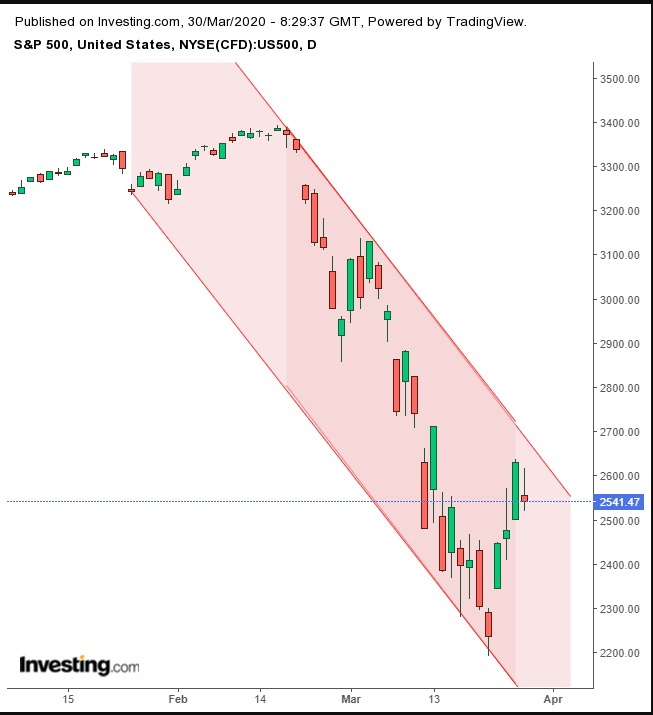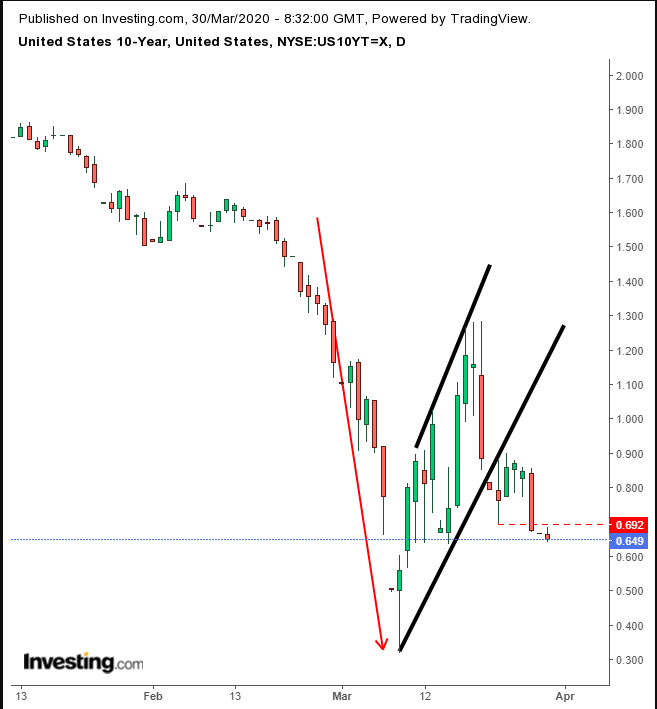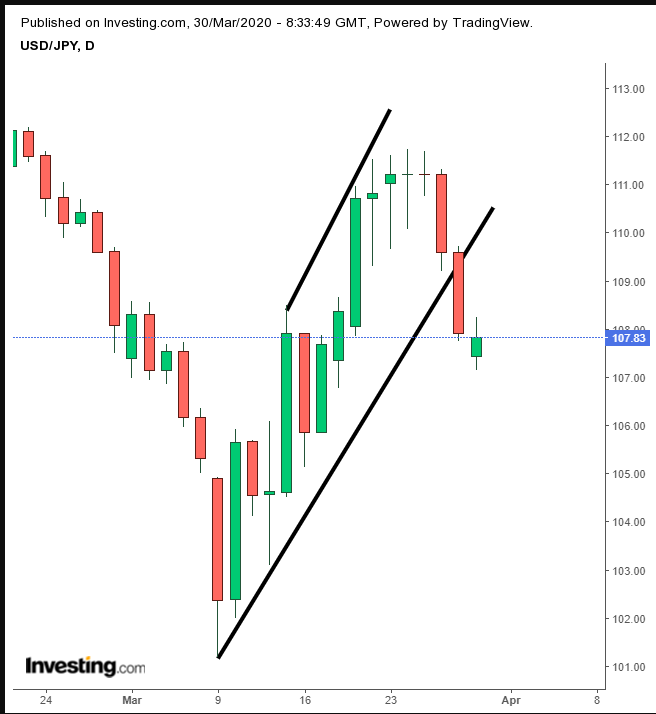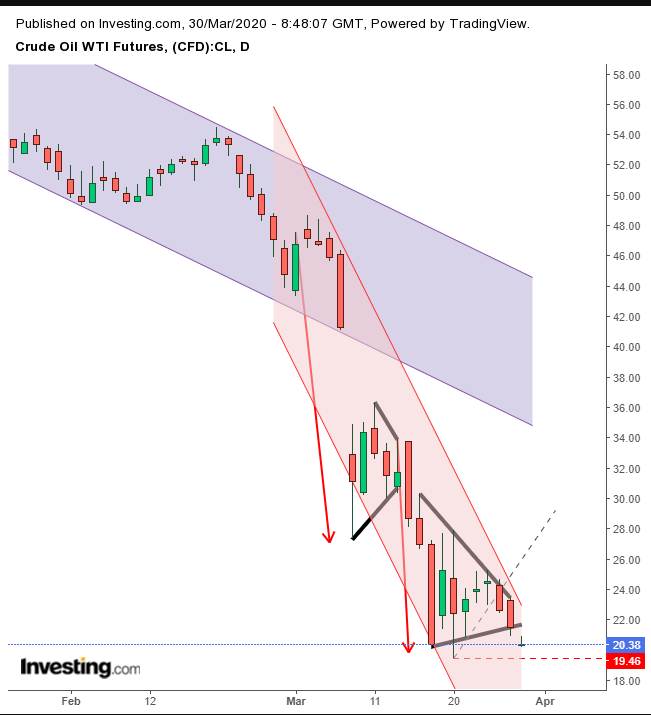- Coronavirus risk-off sentiment testing last week's gains from biggest U.S. spending bill in history
- Trump's weekend flip-flop on post-virus policy pressuring markets on Monday
- Oil struggling to remain above $20
Key Events
U.S. futures for the Dow, S&P 500 and NASDAQ followed European equities lower this morning, though as of time of writing the latter two remain in the green, after Asian markets finished mostly in the red. Markets started the trading week with investors already pessimistic that, notwithstanding the unprecedented U.S. $2-trillion aid package signed into law last Friday, the carnage caused by the worst pandemic this century won't so easily be undone.
Even over the weekend, the ongoing situation kept changing. With more than 143,000 COVID-19 cases currently confirmed in the United States, as well as more than 2,500 fatalities, the president walked back his plan to have the country return to some semblance of normality by Easter. As of Sunday, social distancing guidelines have been extended to April 30.
Oil and gold are both slumping; the U.S. dollar is pushing higher.
Global Financial Affairs
Early Monday, during the Asian session, contracts on the S&P 500 gave up an advance, though they remain positive for now. It's the first Monday in four weeks that the futures contract on the benchmark index didn't hit a limit-down, at least not as of the time of writing. Currently slightly higher, it could to be a sign of some stability during uncertain times.
The energy sector was dragged lower by a drop in oil prices, pressuring the Stoxx Europe 600 Index. It's falling for a second straight session.
Asian indices trimmed more severe declines this morning, though almost all locked in losses. Japan's Nikkei 225 was down 1.57%; Hong Kong's Hang Seng dropped 1.32%. Australia’s ASX 200 was the region contrarian jumping a whopping 7.00% after the government announced AUD$30-billion in stimulus over the next six months.
Wall Street finished the week lower on Friday. Stocks were sold off in the final hour of trade despite the previous three days having been the best for the S&P 500 since 2009. The Dow Jones Industrial Average experienced its best week since 1938, even after Friday’s selloff left 28 of the mega cap index's 30 component stocks in the red.

Notwithstanding the historic gains, we remain bearish and view the rally as a corrective move within a downtrend.
Yields extended last week's decline

The 10-year Treasury yield appears to have sealed the end of a return move to a rising flag, bearish after the preceding plunge.
The dollar rebounded from a six-day selloff, its worst decline since 2009.

However, it continued to weaken versus the yen, a popular safe haven. Technically, the USD tried but failed to return after falling out of a rising channel.
Oil slumped, falling briefly below the $20 mark early Monday.

Global coronavirus lockdowns, which have been bringing national economies to a standstill, are exacerbating an already Biblical-like flood of supply amid a Saudi-Russia price war.
Up Ahead
- Data is expected to start reflecting the current economic situation with U.S. Pending Home Sales anticipated to have plunged in February.
- UK GDP is likely to have fallen to 0% growth in the previous quarter, when the metric is announced on Tuesday.
- Tuesday's German Unemployment Change print is expected to show a leap in March.
- Wednesday’s U.S. ADP Nonfarm Employment release for March is expected to have tumbled significantly while ISM Manufacturing likely contracted further.
- On Thursday, expect US Initial Jobless Claims in the U.S. to skyrocket yet again.
- Friday’s Nonfarm Payrolls release is forecast to show job creation in the U.S. dropped deeply into negative territory in March.
Market Moves
Stocks
- Futures on the S&P 500 Index advanced 0.2%.
- The Stoxx Europe 600 Index decreased 0.6%.
- The MSCI Asia Pacific Index dipped 0.8%.
Currencies
- The euro decreased 0.6% to $1.1078.
- The British pound dipped 0.7% to $1.2371.
- The Japanese yen fell 0.1% to 107.98 per dollar.
Bonds
- The yield on 10-year Treasuries climbed less than one basis point to 0.68%.
- Germany’s 10-year yield decreased three basis points to -0.51%.
- Britain’s 10-year yield declined five basis points to 0.321%.
Commodities
- Gold fell 0.6% to $1,618.89 an ounce.
- West Texas Intermediate crude decreased 4.6% to $20.52 a barrel.
